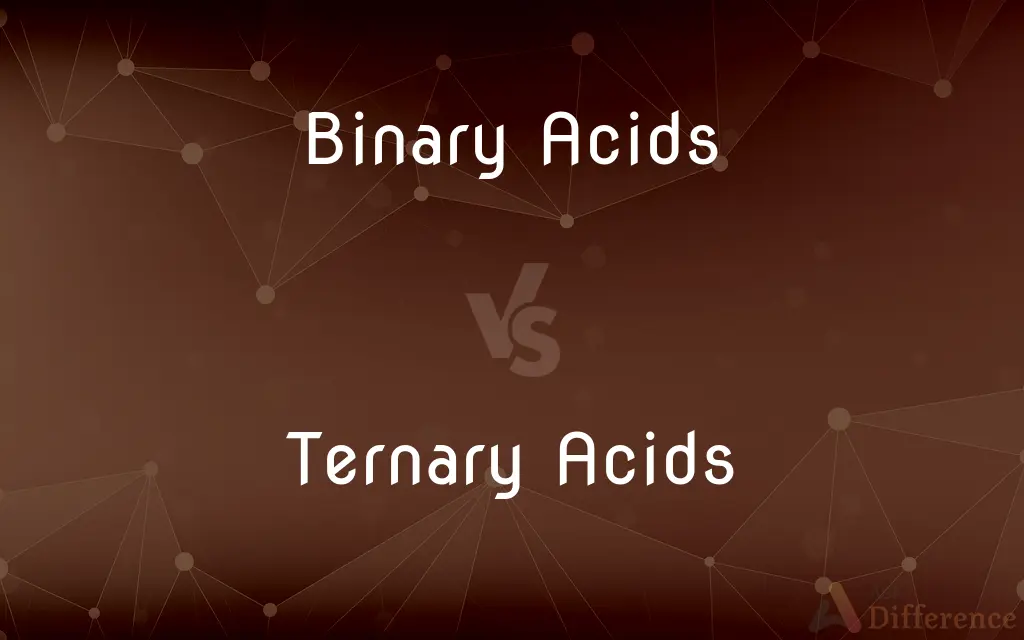Binary Acids vs. Ternary Acids — What's the Difference?
Edited by Tayyaba Rehman — By Fiza Rafique — Published on December 5, 2023
Binary acids contain hydrogen and one other element, while ternary acids contain hydrogen, oxygen, and a third element.

Difference Between Binary Acids and Ternary Acids
Table of Contents
ADVERTISEMENT
Key Differences
Binary acids are simple acids composed of hydrogen and one other non-metal element. On the other hand, ternary acids include not only hydrogen but also oxygen and another non-metal element.
In terms of their molecular structure, binary acids lack the presence of oxygen, leading to their simple composition. In contrast, ternary acids contain oxygen, which facilitates the involvement of another element, thus making their composition more complex.
From a naming perspective, binary acids often have a prefix "hydro-" followed by the root of the non-metal's name and the suffix "-ic." Ternary acids, conversely, typically don't carry the "hydro-" prefix and are named based on the polyatomic anion they contain, which usually ends in "-ate" or "-ite."
As an illustration, binary acids such as hydrochloric acid (HCl) are straightforward in their composition, containing only hydrogen and chlorine. Meanwhile, ternary acids like sulfuric acid (H₂SO₄) have a more intricate make-up with hydrogen, oxygen, and sulfur.
From a reactivity standpoint, the nature of binary acids often leads them to be less oxidizing than ternary acids, due to the absence of the oxidizing agent, oxygen, in their composition. The presence of oxygen in ternary acids generally grants them higher oxidizing capabilities.
ADVERTISEMENT
Comparison Chart
Composition
Hydrogen + one non-metal
Hydrogen + oxygen + one non-metal
Presence of Oxygen
Absent
Present
Naming Prefix
"hydro-"
None, based on polyatomic anion
Example
Hydrochloric acid (HCl)
Sulfuric acid (H₂SO₄)
Oxidizing Capability
Generally less oxidizing
Typically more oxidizing
Compare with Definitions
Binary Acids
Binary acids typically start with the prefix "hydro-" in their nomenclature.
The name hydrofluoric acid indicates it's a binary acid.
Ternary Acids
Ternary acids contain a polyatomic ion in their structure.
Phosphoric acid (H₃PO₄) contains the phosphate ion.
Binary Acids
Binary acids tend to be more straightforward in their composition compared to ternary acids.
Hydrogen and chlorine solely make up hydrochloric acid.
Ternary Acids
The nomenclature of ternary acids doesn't use the prefix "hydro-".
Acetic acid (CH₃COOH) doesn’t begin with hydro-.
Binary Acids
Binary acids lack the presence of oxygen in their molecular structure.
Hydroiodic acid (HI) doesn’t contain oxygen.
Ternary Acids
Ternary acids usually have higher oxidizing capabilities than binary acids due to the presence of oxygen.
Nitric acid (HNO₃) is a strong oxidizing agent.
Binary Acids
Binary acids generally exhibit less oxidizing potential than ternary acids.
Hydrobromic acid is less oxidizing than nitric acid.
Ternary Acids
Ternary acids are named based on the polyatomic anion they contain.
The acid with carbonate is called carbonic acid.
Binary Acids
Binary acids are compounds of hydrogen and one other non-metal element.
Hydrochloric acid (HCl) is a common binary acid.
Ternary Acids
Ternary acids consist of hydrogen, oxygen, and a third non-metal element.
Sulfuric acid (H₂SO₄) is a typical ternary acid.
Common Curiosities
Do binary acids contain oxygen?
No, binary acids do not contain oxygen, while ternary acids do.
Are ternary acids more oxidizing than binary acids?
Generally, yes, due to the presence of oxygen in ternary acids.
What's the basic distinction between binary acids and ternary acids?
Binary acids contain hydrogen and one other element, while ternary acids consist of hydrogen, oxygen, and a third element.
What's a common example of a binary acid?
A common example is hydrochloric acid (HCl).
Do ternary acids ever use the "hydro-" prefix?
No, the "hydro-" prefix is typical for binary acids, not ternary ones.
Can you give an example of a ternary acid?
Sure! Sulfuric acid (H₂SO₄) is a well-known ternary acid.
Why are they called binary and ternary acids?
"Binary" refers to two components (hydrogen + one other element) while "ternary" signifies three components (hydrogen + oxygen + a third element).
Are binary acids less complex than ternary acids?
Yes, binary acids have a more straightforward composition than ternary acids.
How do I recognize a ternary acid by its name?
Ternary acids are typically named based on the polyatomic anion they contain, like sulfuric acid from sulfate.
Which acid type would phosphoric acid (H₃PO₄) fall under?
Phosphoric acid is a ternary acid.
Do all binary acids have the "hydro-" prefix?
Typically, yes, binary acids often use the "hydro-" prefix in their nomenclature.
How do binary acids typically start in terms of naming?
They often start with the prefix "hydro-".
Is the oxidizing capability always higher in ternary acids than in binary acids?
While there are exceptions, ternary acids usually have a higher oxidizing capability due to the presence of oxygen.
What makes up the composition of a binary acid?
A binary acid is composed of hydrogen and one other non-metal element.
How are ternary acids generally named?
They are named based on the polyatomic anion they contain.
Share Your Discovery

Previous Comparison
Polar Bonds vs. Nonpolar Bonds
Next Comparison
Real Number vs. Rational NumberAuthor Spotlight
Written by
Fiza RafiqueFiza Rafique is a skilled content writer at AskDifference.com, where she meticulously refines and enhances written pieces. Drawing from her vast editorial expertise, Fiza ensures clarity, accuracy, and precision in every article. Passionate about language, she continually seeks to elevate the quality of content for readers worldwide.
Edited by
Tayyaba RehmanTayyaba Rehman is a distinguished writer, currently serving as a primary contributor to askdifference.com. As a researcher in semantics and etymology, Tayyaba's passion for the complexity of languages and their distinctions has found a perfect home on the platform. Tayyaba delves into the intricacies of language, distinguishing between commonly confused words and phrases, thereby providing clarity for readers worldwide.











































